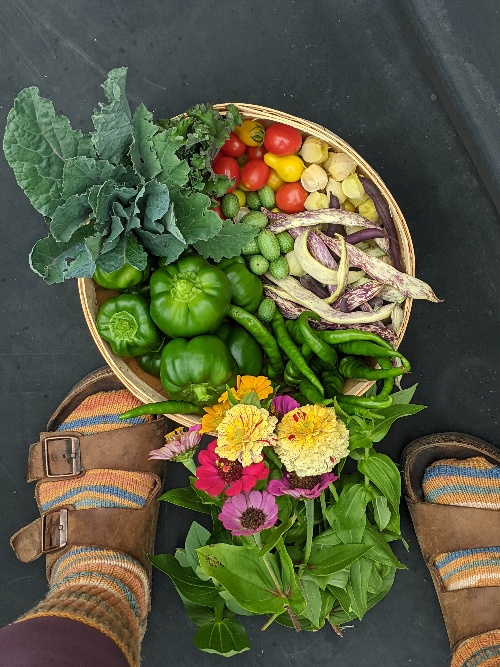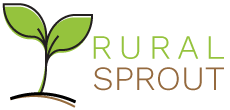
If you still haven’t tried mycorrhizae, consider this your wake-up call – your plants are missing out! Your vegetables, your houseplants, the flowers you plant in the front flower bed, that new apple tree, and your blueberry bushes – nearly everything you plant can benefit from mycorrhizae.
And those benefits make a big difference, year after year.
Well, That Escalated Quickly

It’s been roughly four years since I first wrote about mycorrhizae here on Rural Sprout. Since that time, it’s blown up!
Back in 2021, I had to special order it to use it in my garden. Now, it’s everywhere and in everything. You can get it at Lowe’s, Home Depot, or even Walmart. (I get mine from here.) You can find it mixed in with biochar, fertilizer, and even potting soil.
Not to mention, there’s been more research rolling in showing the importance of this natural symbiotic relationship.
Yet, there are still gardeners who haven’t experienced the benefits of mycorrhizal fungi. It’s clear some of you still need convincing, so here are the five most important things that happen when you add mycorrhizae to your planting hole – short, sweet, and to the point.
As soon as you add mycorrhizae to the planting hole when planting your seedlings, saplings, flowers, bush, repotting houseplants, etc., the fungi go to work. They bond with the plant’s existing root system, expanding it and creating a much larger root surface area than the plant would grow on its own. The following things happen as a result:
Improved Nutrient Uptake

The fungi enhance plants’ abilities to take up nutrients more efficiently simply by increasing the surface area of the root system – more roots means the plant receives more nutrients and water. But it doesn’t stop there. Often, the nutrients in the soil aren’t readily accessible to plants. They’re bound up and need to be broken down before plants can use them. The mycorrhizal fungi do just that, “predigesting” the nutrients before passing them along to the plant.
These fungi are especially great at moving along nitrogen and phosphorus, which, if you know your nutrients, means healthy foliage and lots of flowers and fruit.
Exceptional Drought Resistance

The past few years have been a wild ride when it comes to gardening. One month, I’m looking out my window and hoping someone will turn the rain off, and the next, it’s been six weeks since they did!
Thankfully, the fungi hanging out in the soil with my plants can take it all in stride. Because the plants now have root structures that are larger and deeper than without mycorrhizae, the plants can stand up to drought better. That improved surface area and deeper growth means the plants are better at extracting every last bit of moisture from the soil and can reach water much deeper in the ground.
Likewise, the fungi can slow water uptake when there is plenty of water, making them almost like little water regulators beneath the soil, ensuring your plants get the right amount of water when they need it.
Of course, if the weather is really bad, even those little hard-working fungi will call it quits. But using mycorrhizae in your garden can be the difference between a good year and losing crops to drought.
Disease Defenders
Oh yes, it keeps getting better. I feel like I’m revealing the prizes on a game show. Studies have shown, and many gardeners can attest, that mycorrhizal fungi improve plant resistance to certain soil-borne pathogens—the fungi prime plant defense mechanisms, beefing up the plant’s resistance to diseases.
There’s a lot we don’t understand about how this works, but one thing is clear – it works! If you want the science, you can read more about it here.
Environmental Stress Protection
I know we already covered improved drought resistance, but mycorrhizae can help protect plants from other environmental stressors, too. They assist plants by detoxifying pollutants in the soil, improving the plant’s health. So, things like heavy metals in the soil, salty soil and other pollutants. None of this is surprising when you look at all the research out there showing many species of fungi’s ability to remove toxins. There are even plastic-eating fungi!
Improve Soil Structure and Erosion Control

This neat little party trick is important whether you grow directly in the ground or raised beds. Mycorrhizal fungi provide erosion control by creating a vast network beneath the ground, locking soil in place. But it goes beyond just keeping soil put. The fungi also promote soil microbial activity. They are natural composters, too, accumulating and breaking down organic matter in the soil that slowly improves the soil over time and releases nutrients to feed plants.
This is a big reason why we’re fans of no-dig gardening. When you put away the rototiller, these natural ecosystems below the soil have a chance to grow stronger and bigger with every year benefitting all the plants growing near them.
Not Everyone Gets to Go to the Fungi Party
You will note that at the beginning of the article, I said nearly everything you plant will benefit from using mycorrhizal fungi. There are some plants we grow in our gardens each year that don’t form a symbiotic relationship with fungi.
Those are your brassicas: kale, cabbage, broccoli, cauliflower and the like. While they don’t need these fungi, they won’t be harmed by them. Brassicas are the soil loners, preferring, as Whitesnake does, to go it alone. Like a drifter, Brassicas were born to grow alone. 80s hair bands and broccoli; who knew?

How To Use Mycorrhizal Fungi

With mycorrhizae so easy to get your hands on these days (this is the one I use) and all these great benefits laid out for you, you owe it to your garden to give it a try this year. I have a feeling that once you see what these helpful fungi can do firsthand, you won’t garden without them.
And now that I’ve got you convinced to give mycorrhizae a try, here’s what to do with it once you get it. Plus, I’ll share my “turkey baster” trick to give mature plants a big old dose of mycorrhizae.

Get the famous Rural Sprout newsletter delivered to your inbox.
Including Sunday musings from our editor, Tracey, as well as “What’s Up Wednesday” our roundup of what’s in season and new article updates and alerts.



